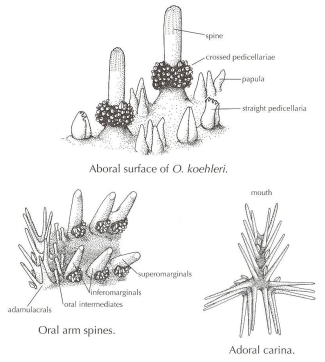Orthasterias koehleri is a strikingly colourful large long-armed sea star with reddish banding around the arms between white or cream patches and prominent white or purple spines. Some individuals are a plain straw colour or a shade of blue. O. koehleri has five arms up to 25 cm long and an arm-to-disc ratio of 6.5 to 10.0. The arms have a row of carinal spines, each 4 to 5 mm long, with two or three series of similar well-spaced rows of spines on each side of the carinals. The aboral spines have a wreath of crossed pedicellariae at the base. Lanceolate pedicellariae, which vary from straight and pointed to broad and toothed, occur between the spines. The papulae occur in groups of three to five. A regular series of 80 to 85 superomarginals, with spines similar to aborals, curves upward in the interradial region to meet the series from the adjacent arm. Each spine has a wreath of crossed pedicellariae. An obvious intermarginal channel, with occasional lanceolate pedicellariae, separates this series from the two series of stout inferomarginal spines each with a tuft of crossed pedicellariae on distal side only. Oral intermediates consist of a single row of stout spines between the inferomarginals and adambulacrals. The adambulacrals have two slender diverging spines at right angles to the furrow, with a lanceolate pedicellaria at the base. Three to five adambulacral plates fuse to form an adoral carina. The mouth plates are usually too sunken to be seen clearly.
Characteristics
Similar SpeciesOrthasterias koehleri is similar to Stylasterias forreri in the aboral spines and wreaths of pedicellariae, but the living colours distinguish them. S. forreri is only black or brown, never red, orange or white. O. koehleri<
